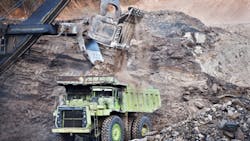Forty-two minders died on the job in 2013, up from 36 in 2012, according to preliminary data from MSHA.
Although fatality and injury rates hit record lows during the first nine months of 2013, according to MSHA, 15 mining deaths in the final three months of the year pushed the total body count to 42.
In 2013, there were 20 coalmining fatalities and 22 metal/nonmetal mining fatalities. In 2012, there were 20 coalmining fatalities and 16 metal/nonmetal mining fatalities.
“Mining deaths are preventable, and those that occurred in 2013 are no exception,” said Joseph Main, assistant secretary of labor for mine safety and health. “While we have made a number of improvements and have been moving mine safety in the right direction, the increased number of metal/nonmetal deaths makes clear we need to do more to protect our nation’s miners.”
Parsing through the preliminary data, MSHA determined that:
- Four mining deaths involved contractors (two each in coal and metal/nonmetal), marking the fewest number of contractor deaths since MSHA began maintaining contractor data in 1983.
- Fourteen of the coalmining deaths occurred underground and six occurred at surface operations.
- In metal/nonmetal mining, five deaths occurred underground, and 17 occurred at surface operations.
- The most common causes of mining accidents involved machinery and powered haulage equipment.
- West Virginia had the most coal mining deaths, with six, and Kentucky had the most metal/nonmetal mining deaths, with four.
To prevent fatalities, Main emphasized that mine operators must maintain effective safety and health management programs that are constantly evaluated; continue find-and-fix programs to identify and eliminate mine hazards; and provide training for all mining personnel.
MSHA said it has implemented several measures to prevent mining deaths, including:
- Increasing surveillance and strategic enforcement through impact inspections at mines with troubling compliance histories.
- Enhancing pattern of violations actions.
- Implementing special initiatives, such as “Rules to Live By,” which focuses attention on the most common causes of mining deaths.
- Engaging in outreach efforts with the mining community.
“It takes the entire mining community to continue to reach new milestones in health and safety,” Main said. “Miners need the reassurance that they will return home safe and healthy after every shift.”
